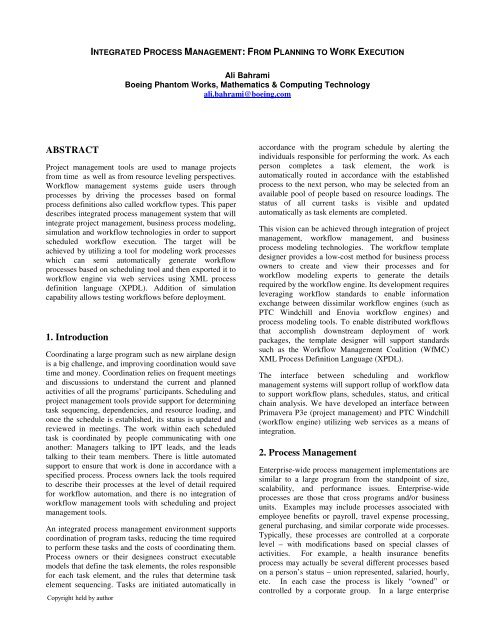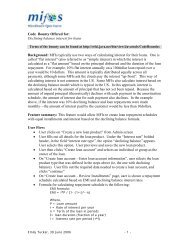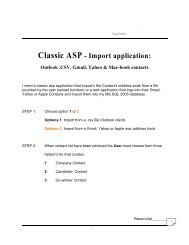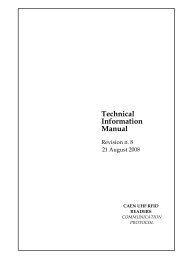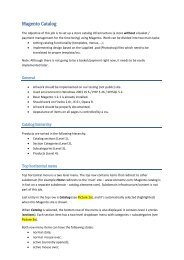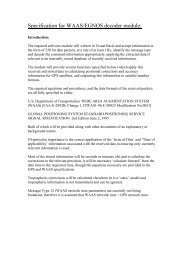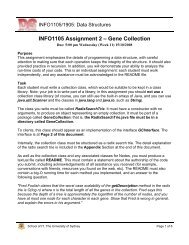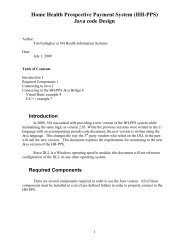Integrated process management: from planning to work execution
Integrated process management: from planning to work execution
Integrated process management: from planning to work execution
Create successful ePaper yourself
Turn your PDF publications into a flip-book with our unique Google optimized e-Paper software.
INTEGRATED PROCESS MANAGEMENT: FROM PLANNING TO WORK EXECUTION<br />
Ali Bahrami<br />
Boeing Phan<strong>to</strong>m Works, Mathematics & Computing Technology<br />
ali.bahrami@boeing.com<br />
ABSTRACT<br />
Project <strong>management</strong> <strong>to</strong>ols are used <strong>to</strong> manage projects<br />
<strong>from</strong> time as well as <strong>from</strong> resource leveling perspectives.<br />
Workflow <strong>management</strong> systems guide users through<br />
<strong>process</strong>es by driving the <strong>process</strong>es based on formal<br />
<strong>process</strong> definitions also called <strong>work</strong>flow types. This paper<br />
describes integrated <strong>process</strong> <strong>management</strong> system that will<br />
integrate project <strong>management</strong>, business <strong>process</strong> modeling,<br />
simulation and <strong>work</strong>flow technologies in order <strong>to</strong> support<br />
scheduled <strong>work</strong>flow <strong>execution</strong>. The target will be<br />
achieved by utilizing a <strong>to</strong>ol for modeling <strong>work</strong> <strong>process</strong>es<br />
which can semi au<strong>to</strong>matically generate <strong>work</strong>flow<br />
<strong>process</strong>es based on scheduling <strong>to</strong>ol and then exported it <strong>to</strong><br />
<strong>work</strong>flow engine via web services using XML <strong>process</strong><br />
definition language (XPDL). Addition of simulation<br />
capability allows testing <strong>work</strong>flows before deployment.<br />
1. Introduction<br />
Coordinating a large program such as new airplane design<br />
is a big challenge, and improving coordination would save<br />
time and money. Coordination relies on frequent meetings<br />
and discussions <strong>to</strong> understand the current and planned<br />
activities of all the programs’ participants. Scheduling and<br />
project <strong>management</strong> <strong>to</strong>ols provide support for determining<br />
task sequencing, dependencies, and resource loading, and<br />
once the schedule is established, its status is updated and<br />
reviewed in meetings. The <strong>work</strong> within each scheduled<br />
task is coordinated by people communicating with one<br />
another: Managers talking <strong>to</strong> IPT leads, and the leads<br />
talking <strong>to</strong> their team members. There is little au<strong>to</strong>mated<br />
support <strong>to</strong> ensure that <strong>work</strong> is done in accordance with a<br />
specified <strong>process</strong>. Process owners lack the <strong>to</strong>ols required<br />
<strong>to</strong> describe their <strong>process</strong>es at the level of detail required<br />
for <strong>work</strong>flow au<strong>to</strong>mation, and there is no integration of<br />
<strong>work</strong>flow <strong>management</strong> <strong>to</strong>ols with scheduling and project<br />
<strong>management</strong> <strong>to</strong>ols.<br />
An integrated <strong>process</strong> <strong>management</strong> environment supports<br />
coordination of program tasks, reducing the time required<br />
<strong>to</strong> perform these tasks and the costs of coordinating them.<br />
Process owners or their designees construct executable<br />
models that define the task elements, the roles responsible<br />
for each task element, and the rules that determine task<br />
element sequencing. Tasks are initiated au<strong>to</strong>matically in<br />
Copyright held by author<br />
accordance with the program schedule by alerting the<br />
individuals responsible for performing the <strong>work</strong>. As each<br />
person completes a task element, the <strong>work</strong> is<br />
au<strong>to</strong>matically routed in accordance with the established<br />
<strong>process</strong> <strong>to</strong> the next person, who may be selected <strong>from</strong> an<br />
available pool of people based on resource loadings. The<br />
status of all current tasks is visible and updated<br />
au<strong>to</strong>matically as task elements are completed.<br />
This vision can be achieved through integration of project<br />
<strong>management</strong>, <strong>work</strong>flow <strong>management</strong>, and business<br />
<strong>process</strong> modeling technologies. The <strong>work</strong>flow template<br />
designer provides a low-cost method for business <strong>process</strong><br />
owners <strong>to</strong> create and view their <strong>process</strong>es and for<br />
<strong>work</strong>flow modeling experts <strong>to</strong> generate the details<br />
required by the <strong>work</strong>flow engine. Its development requires<br />
leveraging <strong>work</strong>flow standards <strong>to</strong> enable information<br />
exchange between dissimilar <strong>work</strong>flow engines (such as<br />
PTC Windchill and Enovia <strong>work</strong>flow engines) and<br />
<strong>process</strong> modeling <strong>to</strong>ols. To enable distributed <strong>work</strong>flows<br />
that accomplish downstream deployment of <strong>work</strong><br />
packages, the template designer will support standards<br />
such as the Workflow Management Coalition (WfMC)<br />
XML Process Definition Language (XPDL).<br />
The interface between scheduling and <strong>work</strong>flow<br />
<strong>management</strong> systems will support rollup of <strong>work</strong>flow data<br />
<strong>to</strong> support <strong>work</strong>flow plans, schedules, status, and critical<br />
chain analysis. We have developed an interface between<br />
Primavera P3e (project <strong>management</strong>) and PTC Windchill<br />
(<strong>work</strong>flow engine) utilizing web services as a means of<br />
integration.<br />
2. Process Management<br />
Enterprise-wide <strong>process</strong> <strong>management</strong> implementations are<br />
similar <strong>to</strong> a large program <strong>from</strong> the standpoint of size,<br />
scalability, and performance issues. Enterprise-wide<br />
<strong>process</strong>es are those that cross programs and/or business<br />
units. Examples may include <strong>process</strong>es associated with<br />
employee benefits or payroll, travel expense <strong>process</strong>ing,<br />
general purchasing, and similar corporate wide <strong>process</strong>es.<br />
Typically, these <strong>process</strong>es are controlled at a corporate<br />
level – with modifications based on special classes of<br />
activities. For example, a health insurance benefits<br />
<strong>process</strong> may actually be several different <strong>process</strong>es based<br />
on a person’s status – union represented, salaried, hourly,<br />
etc. In each case the <strong>process</strong> is likely “owned” or<br />
controlled by a corporate group. In a large enterprise
these types of implementations require <strong>work</strong>flow systems<br />
that are scalable, have high performance, and are available<br />
in a widely distributed environment. In addition, loads on<br />
the system may be very variable depending on a wide<br />
variety of circumstances. Some level of surge capability<br />
is needed so that performance is relatively consistent<br />
across a broad range of user access loads. The user<br />
interface must be user friendly and deployable without<br />
needing large new support or training infrastructures. The<br />
system must be highly reliable, as business critical<br />
<strong>process</strong>es will be executed.<br />
2.1 Business Process Modeling<br />
A business <strong>process</strong> is a set of one or more linked<br />
procedures or activities that collectively realize a business<br />
objective or policy goal, normally within the context of an<br />
organizational structure defining functional roles and<br />
relationships [1, 3, 4].<br />
Modeling, Simulation and Management System (MS) 2<br />
developed at the Boeing phan<strong>to</strong>m <strong>work</strong>s by author allows<br />
the designer of business <strong>process</strong>es <strong>to</strong> define a static view<br />
of these <strong>process</strong>es using the extended Unified Modeling<br />
Language (UML) activity diagram. More on (MS) 2 in the<br />
next section [2].<br />
• UML Class Diagrams model objects defined within<br />
<strong>process</strong>es as well as data modeling<br />
• UML Use-Case Diagrams express how ac<strong>to</strong>rs (e.g.<br />
people, departments, or applications) and systems<br />
interact <strong>to</strong> accomplish a portion of the business (or<br />
system)<br />
• UML Activity Diagrams model <strong>work</strong>flows and<br />
business <strong>process</strong> definitions for simulations and<br />
<strong>work</strong>flow <strong>execution</strong>.<br />
A <strong>process</strong> designer can represent <strong>process</strong>es at varied<br />
levels of detail ranging <strong>from</strong> step-by-step tasks performed<br />
by a single user <strong>to</strong> highest-level business <strong>process</strong>es that<br />
span enterprises. Because the <strong>process</strong> models are<br />
hierarchical, the designer can shift between these different<br />
perspectives while maintaining overall consistency. The<br />
appropriate level of detail in the activity diagrams depends<br />
on the intended use of the model. The finest (lowest)<br />
level of detail describes the activities of people who<br />
actually perform the individual tasks, e.g. machinists,<br />
fabrica<strong>to</strong>rs etc. The coarsest (highest) level of detail may<br />
be more appropriate for higher level of <strong>management</strong>.<br />
2.1.1 Workflow Template Designer<br />
Workflow template designer uses (MS) 2 <strong>to</strong> define<br />
activities and associate these activities with attributes and<br />
objects. Because (MS) 2 is based on UML, the models it<br />
creates provide support for software development and<br />
system design. The web functionality of (MS) 2 supports<br />
cooperative modeling across organizational boundaries.<br />
The <strong>process</strong> designer may simulate a <strong>process</strong> by providing<br />
dynamic data such as resources, duration, and distribution<br />
probability. This dynamic information is added <strong>to</strong> the<br />
static <strong>process</strong> model and used by the Arena simulation<br />
engine <strong>to</strong> simulate the <strong>process</strong>. (MS) 2 uses UML<br />
diagrams and a representation language based on Use<br />
Cases, Activities, and Class diagrams as illustrated in<br />
Figure 1 and listed below:<br />
Figure 2 (MS) 2<br />
the breadth of the functionalities.<br />
user Interface easily provides access <strong>to</strong><br />
(MS) 2 is a <strong>work</strong> modeling <strong>to</strong>ol, but not a <strong>work</strong>flow<br />
<strong>management</strong> system. Windchill and other <strong>work</strong>flow<br />
<strong>management</strong> systems include their own <strong>to</strong>ols for modeling<br />
<strong>work</strong> <strong>process</strong>es graphically, but these modeling <strong>to</strong>ols lack<br />
the analysis, simulation, and more importantly cross <strong>to</strong>ols<br />
interoperability especially for model exchange [2].<br />
2.2. Project Management<br />
Figure 1. UML Based Business Process Modeling Tool<br />
Supports Industry Standards.<br />
Numerous models exist for managing projects, but each<br />
includes a similar set of basic phases: project definition,<br />
project <strong>planning</strong>, performance tracking and project<br />
closure.
During project definition one establishes the frame<strong>work</strong><br />
for the project, including the following:<br />
• Project scope, describing the <strong>work</strong> <strong>to</strong> be done,<br />
defining objectives and clarifying them against other<br />
organizational priorities<br />
• Resources, identifying the people, equipment and<br />
materials you will need<br />
• Project limits, describing project assumptions,<br />
determining constraints such as cost or schedule, and<br />
clarifying risk<br />
An effective plan provides the direction for a project,<br />
maintaining information about scope, resources and<br />
schedule in one place. Developing a project plan involves<br />
the following steps:<br />
• Work breakdown, identifying project tasks and<br />
determining the skills required <strong>to</strong> accomplish ach one<br />
• Time estimates, determining the time involved, or<br />
duration of each task<br />
• Task dependencies, establishing how tasks relate <strong>to</strong><br />
each other and the order in which they must be<br />
completed<br />
• Task constraints, identifying specific task issues, such<br />
as schedule constraints or lack of certain people or<br />
skills<br />
Tracking mechanisms help you evaluate your project's<br />
progress by analyzing performance against specific<br />
criteria. By regularly reviewing results, you can better<br />
direct and refine the project. Tracking performance<br />
involves the following:<br />
• Comparing actual progress against planned estimates.<br />
Comparing where you are with where you planned <strong>to</strong><br />
be can pinpoint areas that may put your project at<br />
risk, such as slower-than-expected progress.<br />
• Identifying issues. Identifying issues as they arise<br />
helps ensure that you are aware of potential problems<br />
that may affect the project scope, resources or<br />
schedule.<br />
• Reviewing resource and schedule requirements.<br />
Overloading one or more members of the project<br />
team is one of the most common causes for schedule<br />
delays.<br />
2.3 Workflow Management<br />
Workflow is the au<strong>to</strong>mation of a business <strong>process</strong>, in<br />
whole or part, during which documents, information, or<br />
tasks are passed <strong>from</strong> one participant <strong>to</strong> another or among<br />
business partners for action, according <strong>to</strong> a set of<br />
procedural rules. Workflows also represent the order in<br />
which individual activity steps are <strong>to</strong> be executed, the<br />
conditions for the activation of an activity, the <strong>to</strong>ols for<br />
the <strong>execution</strong> of an activity, the people resources and<br />
other applications that may be needed for the activity<br />
<strong>execution</strong>, among other things.<br />
A <strong>work</strong>flow <strong>management</strong> system (WfMSs) defines,<br />
creates, and manages the <strong>execution</strong> of <strong>work</strong>flows through<br />
the use of software, running on one or more <strong>work</strong>flow<br />
engines, which is able <strong>to</strong> interpret the <strong>process</strong> definition,<br />
interact with <strong>work</strong>flow participants and, where required,<br />
invoke the use of information technology <strong>to</strong>ols and<br />
applications. Workflow <strong>management</strong> systems (WfMSs),<br />
in general, are used <strong>to</strong> coordinate and streamline<br />
<strong>work</strong>flows and hence business <strong>process</strong>es. WfMS include<br />
<strong>to</strong>ols for <strong>work</strong>flow definition and design, <strong>work</strong>flow<br />
instantiation and control, external applications integration<br />
<strong>to</strong> execute individual activities and <strong>work</strong>flow<br />
administration and moni<strong>to</strong>ring. WfMSs assign individual<br />
activities using mechanisms such as <strong>work</strong>lists for<br />
<strong>execution</strong> of activities that include user interaction - the<br />
user need not necessarily be aware of the higher level<br />
<strong>work</strong>flow <strong>to</strong> which the activity belongs. Addition of<br />
simulation capability allows testing <strong>work</strong>flows before<br />
deployment.<br />
A commonly used analogy that positions WfMSs in the<br />
computing domain is as follows. While databases<br />
guarantee the safe s<strong>to</strong>rage and easy access <strong>to</strong> massive<br />
amounts of data, <strong>work</strong>flow <strong>management</strong> systems are<br />
intended as the basic support for the business/<strong>process</strong><br />
flows in those same environments where databases are<br />
used. The successful incorporation of WfMSs in<strong>to</strong> a<br />
business <strong>work</strong>place greatly depends on the ability <strong>to</strong> make<br />
<strong>work</strong>flows a technology as mature and resilient as existing<br />
databases (following the same evolutionary track of<br />
<strong>to</strong>day’s widely prevalent relational DBMSs) [5].<br />
For effective productivity improvement, best practices<br />
implementation, supply chain linkage, and <strong>process</strong> based<br />
<strong>management</strong> there is a fundamental need <strong>to</strong> focus on<br />
au<strong>to</strong>mating the assortment of manual activities executed<br />
among enterprises. The genesis of this opportunity comes<br />
<strong>from</strong> the reality that business activities among enterprises<br />
<strong>to</strong>day are still typically performed manually. For effective<br />
productivity improvement, best practices implementation,<br />
supply chain linkage, and <strong>process</strong> based <strong>management</strong><br />
there is a fundamental need <strong>to</strong> focus on au<strong>to</strong>mating the<br />
assortment of manual activities executed among<br />
enterprises. Major benefit of WfMS is that they allow the<br />
“au<strong>to</strong>mation” of business <strong>process</strong>es. Au<strong>to</strong>mation does not<br />
mean <strong>to</strong> “control” or <strong>to</strong> “force” a user <strong>to</strong> perform in a<br />
certain way [ 4, 6, 7, 10]. Au<strong>to</strong>mation means that business<br />
<strong>process</strong> steps and their dependencies (data, control, etc.)<br />
are specified formally and that a WfMS can support the<br />
user based on this formal specification. For example, a<br />
WfMS can deliver documents, alert the user of priorities<br />
and deadlines, and can route information according <strong>to</strong><br />
company policies. WfMS are not only targeted <strong>to</strong> human<br />
user environment.
They are also able <strong>to</strong> implement <strong>process</strong>es between<br />
software systems not requiring user communication but<br />
perform by invoking software services directly.<br />
Furthermore, since WfMS au<strong>to</strong>mates a business <strong>process</strong><br />
as a repeatable sequence of subtasks, it makes each<br />
<strong>process</strong> explicit and well defined in the information<br />
technology infrastructure. This makes it amenable <strong>to</strong><br />
moni<strong>to</strong>ring and change in a way that is not possible when<br />
a <strong>process</strong> is simply built in<strong>to</strong> specific application code.<br />
Workflow technology typically involves integrating other<br />
information technologies (such as document <strong>management</strong>,<br />
product data <strong>management</strong>, and collaboration technologies)<br />
<strong>to</strong> support the <strong>management</strong> and <strong>execution</strong> of business<br />
<strong>process</strong>es.<br />
3. Benefits of <strong>Integrated</strong> Process<br />
Management<br />
The benefits of modeling the best practices not only<br />
derived <strong>from</strong> the au<strong>to</strong>mation of time-consuming<br />
administrative tasks (such as tracking, moni<strong>to</strong>ring, and<br />
notification), but also by the detailed, on-line<br />
documentation of those <strong>process</strong>es, which increases their<br />
visibility and reusability throughout the enterprise.<br />
In order <strong>to</strong> realize these benefits, the business <strong>process</strong>es<br />
managed by <strong>work</strong>flow technology should be amenable <strong>to</strong><br />
being unders<strong>to</strong>od, modeled (i.e., represented as sequential<br />
flows of tasks), executed (i.e., carried out by a identifiable<br />
participants), moni<strong>to</strong>red (i.e., identifiable as having being<br />
started and completed), coordinated, (i.e., having some<br />
sequential constraints on the order of subtasks), shared<br />
(i.e., having subtasks that may be carried out by different<br />
participants), repeated (i.e., executed many, separate times<br />
in an organization), and, in some cases, simulated (i.e.,<br />
able <strong>to</strong> estimate performance metrics). If a business<br />
<strong>process</strong> meets these criteria, then the level of benefit <strong>from</strong><br />
<strong>work</strong>flow <strong>management</strong> often depends on the degree <strong>to</strong><br />
which the business <strong>process</strong> can take advantage of the<br />
other information technologies that are integrated with the<br />
particular <strong>work</strong>flow manager.<br />
The key benefits of integrated <strong>process</strong> <strong>management</strong> are as<br />
follows:<br />
• Tool/Vendor Neutral Workflow Process Definition -<br />
define once, execute any where.<br />
• Reusing library of Process Components and<br />
knowledge captured in the PM. Enabling fast<br />
<strong>work</strong>flow development in accordance with PM and<br />
vise-versa.<br />
• Workflows are executed according <strong>to</strong> schedule - no<br />
arbitrary <strong>work</strong>flow <strong>execution</strong>.<br />
• Schedule changes reflected in WFMS - real <strong>work</strong><br />
<strong>execution</strong> affected.<br />
• Ad-hoc changes in WFMS reflected in schedule -<br />
additions / deletions / modifications sent <strong>to</strong> schedule.<br />
• Schedule shows always correct status and his<strong>to</strong>ry<br />
• Improved efficiency - by the detailed model of long<br />
running <strong>process</strong>es one can find clues <strong>to</strong> <strong>process</strong><br />
inefficiency. Furthermore, au<strong>to</strong>mation of business<br />
<strong>process</strong>es results in the elimination of timeconsuming,<br />
manual steps, such as routing documents<br />
between subtask participants.<br />
• Better <strong>process</strong> control - improved <strong>management</strong> of<br />
business <strong>process</strong>es results <strong>from</strong> standardizing the<br />
subtasks involved in a <strong>process</strong> and in the availability<br />
of audit trails.<br />
• Improved visibility and documentation – participants<br />
are better able <strong>to</strong> moni<strong>to</strong>r upcoming tasks and <strong>to</strong><br />
understand their interfaces with the participants of<br />
other subtasks.<br />
• Flexibility – using software <strong>to</strong> manage business<br />
<strong>process</strong>es enables their re-design with changing<br />
business needs and the tracking of any ad hoc<br />
modifications <strong>to</strong> the <strong>process</strong>es.<br />
• Business <strong>process</strong> improvement – design and<br />
simulation <strong>to</strong>ols facilitate the modeling of coherent,<br />
efficient business <strong>process</strong>es.<br />
4. <strong>Integrated</strong> Process Management<br />
Architecture<br />
The integrated <strong>process</strong> <strong>management</strong> architecture addresses<br />
integration of scheduling systems (such as Primavera P3e)<br />
with <strong>work</strong>flow <strong>management</strong> systems (implemented using<br />
a <strong>to</strong>ol such as PTC Windchill or Enovia) and <strong>process</strong><br />
modeling <strong>to</strong>ol – (MS) 2 .<br />
Scheduling and <strong>work</strong>flow systems both manage the flow<br />
of <strong>work</strong>, but they emphasize different aspects of the <strong>work</strong>.<br />
Scheduling systems emphasize analyzing the<br />
dependencies between tasks and using those dependencies<br />
<strong>to</strong> plan the human and temporal resources required <strong>to</strong><br />
perform the <strong>work</strong>. These systems enable <strong>management</strong> <strong>to</strong><br />
determine what resources will be required, when they will<br />
be required, and how long it will take <strong>to</strong> complete a<br />
project. The systems may also provide a prioritized<br />
activity list or <strong>work</strong> list <strong>to</strong> the people responsible for<br />
performing the <strong>work</strong>. Workflow <strong>management</strong> systems<br />
emphasize the implementation of the <strong>work</strong> via the <strong>process</strong><br />
flow, including conditional branches and loops in the<br />
<strong>process</strong>. These systems provide <strong>management</strong> with<br />
visibility of the current status of every <strong>process</strong> instance<br />
and assurance that the <strong>work</strong> is done in accordance with the<br />
<strong>process</strong>. Workflow <strong>management</strong> systems alert the people<br />
who must do the <strong>work</strong> of the tasks assigned <strong>to</strong> them, and<br />
they also provide a <strong>work</strong> list of these tasks. Workflow<br />
systems are generally well integrated with the <strong>work</strong><br />
objects, and they provide links <strong>from</strong> an item in a <strong>work</strong> list
Oct 98 Nov 98<br />
ID Task Name Start Date End Date Duration<br />
222324252627282930311 2 3 4 5 6 7<br />
1 Receive and register package 10/23/1998 10/23/1998 1d<br />
2 Enter Update In<strong>to</strong> ADADS 10/26/1998 10/28/1998 3d<br />
3 Analyze The package Per 10/26/1998 6B0110/29/1998<br />
3d 4h<br />
4 Communicate With Compliance 10/29/1998 10/30/1998 Engineering 1d 4h<br />
5 Enter Data In<strong>to</strong> System 11/2/1998 11/5/1998 3d 4h<br />
6<br />
Backout Data and Return Package To<br />
Engineering<br />
11/2/1998 11/6/1998 4d 4h<br />
<strong>to</strong> the relevant data objects. For example, a task <strong>to</strong><br />
review a design in Enovia would include a link <strong>to</strong> the<br />
design.<br />
<strong>Integrated</strong> Work Management System Architecture<br />
Design Time<br />
<br />
WFMS WindChill<br />
WF<br />
Web Services<br />
PM<br />
P3e<br />
PM<br />
Web Services<br />
and <strong>work</strong>flow engines. Similarly group of vendors<br />
including Microsoft, IBM and others have defined the<br />
Business Process Execution Language (BPEL). Now<br />
being standardized under auspices of OASIS, BPEL is<br />
also an XML-based language for defining interaction via<br />
web services.<br />
XML has emerged as the standard syntax for representing<br />
and exchanging information when independent,<br />
computing applications are involved. So it is a natural<br />
choice <strong>to</strong> base a standard <strong>work</strong>flow <strong>process</strong> definition<br />
language on XML. However, adequately representing the<br />
complex semantics of business <strong>process</strong> definitions is<br />
beyond the scope and purpose of the core XML<br />
!<br />
<br />
<br />
(MS) 2<br />
Reposi<strong>to</strong>ry<br />
<br />
Is collection of web<br />
services for <strong>work</strong>flow,<br />
<strong>process</strong> description,<br />
project <strong>management</strong><br />
and configuration.<br />
Web Services<br />
<br />
WFMS WindChill<br />
WF<br />
<strong>Integrated</strong> Work Management Architecture<br />
Runtime<br />
Intelligent Search<br />
Cus<strong>to</strong>m Items<br />
Web Services<br />
Business Processes<br />
<br />
Workflow status<br />
Project Management<br />
iWork Management Service Broker<br />
Web Services<br />
<br />
Synchronization<br />
Engine<br />
Web Services<br />
PM<br />
P3e<br />
PM<br />
Web Services<br />
<br />
<br />
(MS) 2<br />
Reposi<strong>to</strong>ry<br />
<br />
<br />
<br />
Figure 3 <strong>Integrated</strong> <strong>process</strong> <strong>management</strong> design time<br />
architecture<br />
The target will be achieved by utilizing a <strong>to</strong>ol for<br />
modeling <strong>work</strong> <strong>process</strong>es which can semi au<strong>to</strong>matically<br />
generate <strong>work</strong>flow <strong>process</strong>es based on scheduling <strong>to</strong>ol and<br />
then exported it <strong>to</strong> <strong>work</strong>flow engine via web services<br />
using XML <strong>process</strong> definition language (XPDL) as it is<br />
shown in Figure 3. Run time architecture allows for<br />
synchronization of <strong>work</strong>flow and project <strong>management</strong><br />
resources during <strong>process</strong> instantiation and <strong>work</strong>flow<br />
<strong>execution</strong>. See Figure 4.<br />
Workflow <strong>management</strong> systems require and enable the<br />
definition of business <strong>process</strong>es, typically via a <strong>process</strong>modeling<br />
<strong>to</strong>ol. A <strong>process</strong> definition includes the rules,<br />
constraints, attributes, and relationships of the activities,<br />
participants, roles, and informational items (such as<br />
documents) instrumental <strong>to</strong> the <strong>work</strong>flow. Because<br />
different business <strong>process</strong> <strong>management</strong> server implement<br />
<strong>work</strong>flow modeling in different ways, trying <strong>to</strong> run a<br />
<strong>work</strong>flow model created for one vendor’s product on<br />
another BPM server is unlikely <strong>to</strong> be successful. The<br />
WfMC has been <strong>work</strong>ing on a standard interface<br />
specification <strong>to</strong> enable <strong>process</strong> definitions <strong>to</strong> be passed<br />
<strong>from</strong> modeling <strong>to</strong>ols <strong>to</strong> <strong>work</strong>flow engines in a vendorneutral<br />
way. In late 2002 WfMC released version 1<br />
specification for a Process Definition Language based on<br />
Extensible Markup Language (XML) schema referred <strong>to</strong><br />
as XPDL. XPDL provides a basic foundation for a vendor<br />
neutral, standard interface between <strong>process</strong> modeling <strong>to</strong>ols<br />
Figure 4 <strong>Integrated</strong> <strong>process</strong> <strong>management</strong> run time<br />
architecture<br />
specifications. Information modeling grammars can be<br />
used <strong>to</strong> extend the XML syntax by prescribing how<br />
complex statements can be formed using simple elements.<br />
We have developed capability <strong>to</strong> output XPDL <strong>from</strong><br />
(MS)2 <strong>process</strong> models. The hope is in very near future<br />
every <strong>work</strong>flow <strong>management</strong> system that complies with<br />
the WfMC standards (or other industry standards such as<br />
BPEL) should be able <strong>to</strong> support XML representation of<br />
<strong>process</strong>es. However, currently most <strong>work</strong>flow<br />
<strong>management</strong> systems does not support mentioned<br />
standards. For example, Windchill support only comma<br />
separated value or CSV. We have built the transla<strong>to</strong>r that<br />
take XPDL and convert it <strong>to</strong> CSV for Windchill<br />
consumption [13].<br />
5. Workflow Generation<br />
Once the project plan has been established based on<br />
Critical chain analysis, <strong>work</strong>flow model can be generated<br />
based on scheduled tasks. See Figure 2. The <strong>work</strong>flow<br />
generation wizard will then assist designer in generating<br />
<strong>work</strong>flow (See Figure 5).
There appear <strong>to</strong> be three options for generating <strong>work</strong>flow<br />
<strong>from</strong> project <strong>management</strong> tasks:<br />
1. Simple Task- the scheduling activities and <strong>work</strong>flow<br />
<strong>management</strong> tasks could be in one-<strong>to</strong>-one<br />
correspondence;<br />
augmented by descriptions of conditionals and loops, as<br />
shown. The scheduling <strong>to</strong>ol defines all the resources<br />
responsible for carrying out the <strong>to</strong>tal activity, and<br />
somehow these must be allocated <strong>to</strong> the individual steps.<br />
2. Hierarchical task composed of several sub tasks<br />
corresponds <strong>to</strong> a scheduled task that has not been<br />
designed before;<br />
3. Process Component- same as step 2 but Hierarchical<br />
task has been deigned before.<br />
Figure 6. Hierarchical task composed of several sub<br />
tasks corresponds <strong>to</strong> a scheduled task.<br />
5.3 Process Component- Hierarchical Task Has<br />
Been Deigned Before<br />
Workflow <strong>management</strong> is often used for <strong>process</strong>es such as<br />
engineering change <strong>management</strong> that occur many times<br />
and involve many short duration tasks such as review and<br />
approval tasks. In this case design can reused previously<br />
designed <strong>process</strong>es and retrieve it <strong>from</strong> <strong>process</strong> reposi<strong>to</strong>ry.<br />
<strong>process</strong><br />
component<br />
Figure 5 Workflow au<strong>to</strong> generation <strong>to</strong>ol.<br />
5.1 Simple Task-One-<strong>to</strong>-one Correspondence<br />
The <strong>work</strong>flow tasks and scheduled activities could be in<br />
one-<strong>to</strong>-one correspondence. Both the schedule<br />
representation and the <strong>work</strong>flow representation contain<br />
the same tasks/activities. The <strong>work</strong>flow template could be<br />
initialized <strong>from</strong> this description of steps, but it is likely<br />
that it would have <strong>to</strong> be augmented by descriptions of<br />
decisions and loops.<br />
5.2 Hierarchical Task That Has Not Been<br />
Designed Before<br />
These tasks may all be performed within the same<br />
functional area and correspond <strong>to</strong> steps within a scheduled<br />
activity. In this case, the <strong>work</strong>flow model would represent<br />
the <strong>process</strong> flow within one activity, as shown in the<br />
figure below. The description of a hierarchical activity<br />
may include a sequence of sub activities, and the<br />
<strong>work</strong>flow template could be initialized <strong>from</strong> this<br />
description of steps, but it is likely that it would have <strong>to</strong> be<br />
Figure 7. Process Component refers <strong>to</strong> <strong>process</strong>es that have<br />
been defined and in the library of business <strong>process</strong>es for<br />
reusability.<br />
6. Conclusion<br />
Today, an onslaught of business imperatives is pushing<br />
enterprises <strong>to</strong> au<strong>to</strong>mate the highly complex business or<br />
exchange activities occurring outside of any single<br />
participating enterprise. To thrive and remain competitive,<br />
it will be essential for businesses <strong>to</strong> au<strong>to</strong>mate and<br />
optimize relationships with partners throughout the entire<br />
business lifecycle. Providing services that integrate<br />
project and resource <strong>management</strong> <strong>to</strong>ols with <strong>work</strong>flow<br />
<strong>management</strong> systems can enable efficient <strong>process</strong>
au<strong>to</strong>mation across the large, complex, and distributed<br />
businesses.<br />
References<br />
[1] Apple<strong>to</strong>n, D.S., Business reengineering with business<br />
rules, In V. Grover, & W. J. kettinger (Eds.), Business<br />
Process Change: Reengineering concepts, Methods and<br />
Technologies, , Idea Group Publishing, pp. 291-329,<br />
1995.<br />
[2] Bahrami, A. Modeling and Simulation Management<br />
System (MS)2 User’s Guide, The Boeing company<br />
Version 2, November 2001.<br />
[3] Basu, A., and Kumar, A., “Research commentary:<br />
<strong>work</strong>flow <strong>management</strong> issues in e-business”, Information<br />
System Research, 13(1): 1-14, 2002.<br />
[4] Denna, E. L., Jon Jasperson, Kenny Fong,<br />
Reengineering and REAL business Process Modeling, In<br />
V. Grover, and W.<br />
[5] Fischer Layna (edi<strong>to</strong>r), “The Workflow Handbook<br />
2001,” in association with the Workflow Management<br />
Coalition (WfMC), Oc<strong>to</strong>ber 2000.<br />
[6] Huckvale, T., & M. Ould, “Process modeling - who,<br />
what and how: Role Activity diagramming”, In V. Grover,<br />
and W.<br />
[7] J. Kettinger (Eds.), Business Process Change:<br />
Reengineering concepts, Methods and Technologies, Idea<br />
Group Publishing, pp. 291-329, 1995.<br />
[8] Lin, F.-r., Yang, M.-c., and Pi, Y.-h., “A Generic<br />
Structure for Business Process Modeling”, Business<br />
Process Management Journal, 8(1):19-41, 2002.<br />
[9] Mayer, R.J., Benjamin, P.C., Caraway, B.E., and<br />
Painter, M., A frame<strong>work</strong> and a Suite of method for<br />
business <strong>process</strong> reengineering, In V. Grover, & W. J.<br />
kettinger (Eds.), Business Process Change: Reengineering<br />
concepts, Methods and Technologies, Idea Group<br />
Publishing, pp. 245- 290, 1995.<br />
[10] Swiss Bank Corporation, Switzerland; e-<br />
Workflow.org, Gold Award, Workflow, Europe (1998)<br />
Nominated by Eastman Software, Inc. with integration by<br />
Sys<strong>to</strong>r AG.<br />
[11] Wang, S., “OO modeling of business <strong>process</strong>”,<br />
Information system Management, pp.36-43, spring 1994.<br />
[12] Wooldridge, M. and Jennings N.R., Agent theories,<br />
architectures, and languages: a survey, in M. Wooldridge<br />
and N.R. Jennings (Eds.), Intelligent Agents, Berlin:<br />
Springer-Verlag, pp. 1-22, 1995.<br />
[13] Workflow Process Definition Interface - XML<br />
Process Definition Language (XPDL), WfMC, Oc<strong>to</strong>ber<br />
25, 2002.


